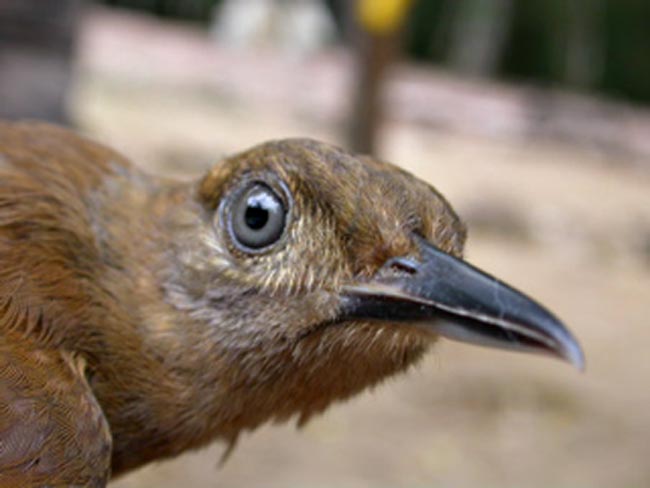Birds Follow Army-Ants to Find Prey

This Behind the Scenes article was provided to LiveScience in partnership with the National Science Foundation.
Crafty birds deep in the jungles of Panama have found a unique hunting strategy: following army ants and picking off prey that try to escape the crawling swarm. Robb Brumfield treks through remote jungle to study these birds – this story is a window into one of his recent trips and insight into his research. Living conditions in the field are never as comfortable as they are at home, but in this case they are downright cushy. I am working at a remote field station named Rancho Frio (Cold Ranch) in the humid lowland jungles of extreme eastern Panama near the border of Colombia. The field station has a large room with bunk beds, a fire pit for cooking and, to my utter surprise, toilets! This is a place that cannot be reached by car, and, for that reason, the forest is spectacularly pristine. To get here I flew from Panama City to an airstrip 6 miles (10 kilometers) away in El Real (The Royal). We hired the only vehicle in town, a pick-up truck owned by the local hospital, to carry our gear to a military checkpoint 4 miles (7 kilometers) south of town. From there, the road ended, so we hired five horses to carry our gear and hiked the rest of the way. The trees in the jungle here include the widest and the tallest I've ever seen. I came to this remote forest because of my research on the evolution of different strategies that antbirds, woodcreepers and ovenbirds use to find their insect prey. One of the most bizarre tactics antbirds and woodcreepers have adopted should be evident here: army-ant-following. A typical encounter with this strange foraging strategy goes something like this: standing in the woods, I see no birds, but I can hear in the distance the snap, crackle and pop of a million marauding army-ants marching through the leaf litter. They are consuming every insect, spider and lizard in their path. And traveling with the army-ants is a boisterous flock of birds. The objective of the army-ant-following birds in this flock is simple: to devour the grasshoppers, katydids, crickets and other insects that think they are escaping death by flying away from the swarm. These arthropod Peyton Farquhars never have a chance. One of the first questions people who witness these flocks ask is, "Do the birds also eat the army-ants?" The answer appears to be no, but the truth is that ornithologists--scientists who study birds--are still unsure. Analyses of the birds' stomach contents reveal a considerable number of army-ants, but this may simply be by-catch--many of the insects eaten by the birds are covered with army-ants. People are also curious whether species of army-ant-following birds come in different levels of specialization. This is definitely true. The first and most common level is composed of the occasional army-ant-followers. These are bird species that will follow an army-ant swarm as it passes through their territory, but will not follow the swarm beyond the limits of their territory. The next step-up in specialization is regular army-ant-followers. These are species that will follow an army-ant swarm beyond the limits of their territory, but are regularly also found foraging independently of swarms. Finally, there are the true specialists: the professional army-ant-followers. These are species that rely entirely on army-ants to flush prey from the forest floor. To study the evolution of army-ant-following, I am using a laboratory tool called a molecular phylogeny. This is essentially a tree that depicts the evolutionary history of the antbird and ovenbird species, much like a genealogical tree depicts the pedigree of a human family. By overlaying a trait of interest, such as army-ant-following, onto the tree, one can understand how it evolved. For example, using a phylogeny of all antbird species, we now know that army-ant-following evolved according to a logical progression: occasional army-ant-following gave rise to regular army-ant-following, which in turn gave rise to professional army-ant-following. Moreover, we can estimate that army-ant-following has been used by antbirds as a way to find food for more than five million years! This is very impressive, especially considering they are largely relying on one species of army-ant (Eciton burchellii). At Rancho Frio, I find what I came here for: specimens of army-ant-following antbirds and ovenbirds. Because we are at the extreme eastern edge of Panama, we can find here South American species, such as the Double-banded Graytail, whose distributions barely make it into Central America. The trip is a success, both because we found the species we were looking for and because we had no encounters with guerillas from neighboring Colombia. These revolutionary soldiers have been fighting the Colombian government since 1964, and one of their main sources of income is ransoms to free people they've kidnapped. It's for this reason that I'm accompanied here by five Panamanian Special Forces soldiers. Fortunately, the only thing I ended up needing their help with was with collecting birds. They made great field assistants, and really enjoyed this unorthodox "mission." Robb Brumfield is Assistant Curator of Genetic Resources and Adjunct Assistant Professor of Biology at the Museum of Natural Science at Louisiana State University. For more information about Brumfield and his research, visit the Brumfield Lab website. Media requests can also be sent to Ashley Berthelot of LSU Public Affairs. More to Explore
- Robb Brumfield's Laboratory Web Site
- LSU Public Affairs Office
Editor's Note: This research was supported by the National Science Foundation (NSF), the federal agency charged with funding basic research and education across all fields of science and engineering.
Get the world’s most fascinating discoveries delivered straight to your inbox.


